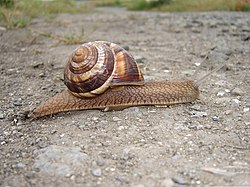Top Qs
Timeline
Chat
Perspective
Helix lucorum
Species of gastropod From Wikipedia, the free encyclopedia
Remove ads
Helix lucorum, known commonly as the Turkish Snail[2], is a species of large, edible, air-breathing land snail, a terrestrial pulmonate gastropod mollusk in the family Helicidae, the typical snails.[1]
Remove ads
Description


Adult snails weigh about 20–25 g.[3]
The width of the shell is 35–60 mm.[4] The height of the shell is 25–45 mm.[4]
This species of snail makes and uses love darts.
Distribution
The native distribution is the Caucasus, Anatolia and, arguably, the Balkans. It has also invaded many other regions since ancient times, likely assisted by humans.[5]
Eastern native range with main genetic diversity of the species:
Balkans (probably native):
Other countries:
- Israel[7]
- Syria
- Russia - could be native in Caucasus, invasive in some other regions[5]
- Italy - probably invasive[5]
- Hungary - probably invasive[5]
- Romania - probably invasive[5]
- Ukraine - invasive, in Crimea ("Helix taurica Krynicki, 1833") at least since early 19 century, probably much longer, these populations originated from Anatolia;[5] other colonies of a different lineage also appear since 2000s in mainland part of Southern Ukraine and in Crimea as well[5][8][9]
- Czech Republic - invasive, since 2009, as of 2011 the only locality is Prague-Žižkov[4][10]
- Slovakia - invasive, since 2013, as of 2014 the only locality is in Bratislava[11]
- France - invasive
- Great Britain - invasive, since 2009, at Wimbledon[12]
Remove ads
Ecology
The diameter of the egg is 4.4 mm.[13] Juvenile snails that are two to three months old weigh 0.5–0.9 g.[3]
Human use
Measurement of DNA damage in H. lucorum collected from environmental sites can be used for evaluating soil pollution at these sites.[14] DNA damage in H. lucorum haemocytes and digestive gland cells is determined by the comet assay.
Helix lucorum is used in cuisine as escargots.
Remove ads
References
External links
Wikiwand - on
Seamless Wikipedia browsing. On steroids.
Remove ads


